Has Iowa’s weather had an impact on how Iowans live?
Weather and climate both deal with the same conditions but in a different way. Weather measures what happens over a short period of time — a day or up to a week. How warm will it be, will it rain or snow, will it be windy? These are conditions that the daily weather report tries to predict. Climate is the average of weather conditions over decades or even centuries. Climate addresses average temperatures in the spring or the rainfall that one might expect in August based on past records.
Iowa and Its Seasons
The climate in Iowa has four seasons — winter, spring, summer and fall. Within each season, however, temperatures and precipitation (rain, snowfall, hail or sleet) can vary significantly from day to day. Because Iowa’s history is so closely tied to agriculture, weather is a significant concern. Corn, soybeans and garden vegetables rely on rainfall and sunshine to mature. Cattle and sheep depend on the growth of grass and other pasture crops. Even Iowans not engaged in farming listen to the weather report to know how to dress for the day or to plan outdoor activities. If you listen to Iowans greeting each other, the weather is often one of the first topics they discuss.
While there are rarely extreme differences in weather patterns across the state, there are frequently some variations. Northern Iowa, especially the northwest, tends to be colder in the winter than southern Iowa. Southeast Iowa receives on average more rainfall each year than the northwest. In the spring, flowers may bloom two or three weeks earlier in southern communities than along Iowa’s border with Minnesota. Leaves turn color earlier in the north.
Extreme Weather
Iowa experiences its share of extreme weather conditions. Tornadoes are rapidly whirling columns of air than may or may not touch ground. When they do, they can cause devastation and even fatalities. Tornadoes are most likely in Iowa in the spring and early summer, but they can develop through fall months as well. A cyclone also brings very strong winds but over a larger area and without the whirling columns of a tornado.
A blizzard is marked by heavy snowfall and driving winds. The word "blizzard" is the creation of a newspaper editor in Estherville, O.C. Bates, who made it up to describe a late snow storm in 1871. Heavy rainfalls over a short period may cause Iowa’s rivers to flood their banks. In recent years, 1993 and 2008 recorded devastating floods.
Because of the importance of weather, the government has created the National Weather Bureau in 1890 to track weather conditions across country. A professional who studies weather conditions is called a meteorologist. Scientists are now claiming that temperatures all over the earth are warming up slightly but significantly because humans are burning gasoline, coal and other fuels that give off gasses that trap heat within the atmosphere. This process is called global warming. We may not notice differences in day-to-day weather but if warming continues, what we know of Iowa’s climate today may not be the same a hundred years from now.
Supporting Questions
What are some of the notable weather events that have impacted Iowa and its citizens?
- "Tornado Rips Oelwein" Newspaper Article, May 16, 1968 (Document)
- "Outstanding Iowa Storms" Essay from The Annals of Iowa, 1970 (Document)
- "Iowa Under Siege" Newspaper Articles, June 10, 2008 (Document)
- "Yep, This Year’s Drier than '88" Newspaper Article, August 1, 2012 (Document)
How has Iowa’s weather affected Iowans?
- Cabinet Card of Relics from Cherokee-Pomeroy Tornado near Aurelia, Iowa, 1893 (Image)
- Portrait of 6-Month-Old Baby Carried by Cherokee-Pomeroy Tornado, 1893 (Image)
- Iowa Public Television's "The Dust Bowl," 1979 (Video)
- Iowa Public Television's "Midwest Farm Fields Devastated by Floods," 2008 (Video)
What have Iowans done in response to Iowa’s extreme weather?
- Men Placing Sandbags to Reinforce Dikes during a Flood in Council Bluffs, Iowa, 1952 (Image)
- Iowa Public Television's "Iowa After the 2008 Parkersburg Tornado," 2008 (Video)
- "Cedar Rapids Flood Buyout is History" Newspaper Article, September 14, 2014 (Document)
- NPR's "MAP: FEMA Is Buying Out Flood-Prone Homes, But Not Where You Might Expect," October 20, 2014 (Image)
| Iowa Weather and Its Impact Source Set Teaching Guide |
| Printable Image and Document Guide |
"Tornado Rips Oelwein" Newspaper Article, May 16, 1968
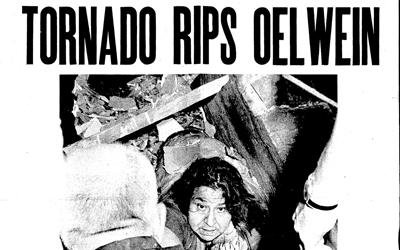
Description
This is a newspaper article published in The Oelwein Daily Register on May 16, 1968, that details the story of a destructive F-5 tornado that ravaged Oelwein, Charles City and Maynard, Iowa. The tornado killed four people in Oelwein and…
"Outstanding Iowa Storms" Essay from The Annals of Iowa, 1970
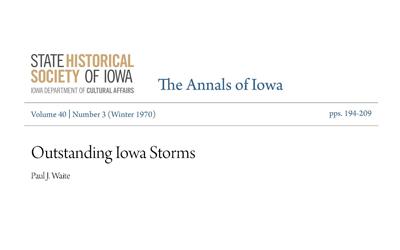
Description
This essay from The Annals of Iowa, written by meteorologist Paul Waite, is about noteworthy, weather-related storms in Iowa. Published in 1970, Waite details some of the most significant weather storms (including winter storms, blizzards and tornadoes) that…
"Iowa Under Siege" Newspaper Articles, June 10, 2008
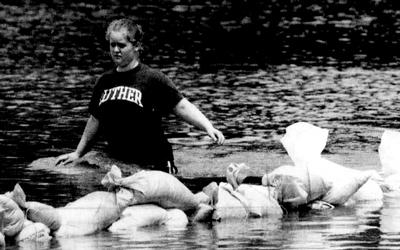
Description
These 2008 Cedar Rapids Gazette articles describe the current and potential flooding in Iowa City and other eastern Iowa communities, as well as how it could impact the University of Iowa campus.
"Yep, This Year’s Drier than ‘88" Newspaper Article, August 1, 2012

Description
This newspaper article from the August 1, 2012, was published by The Cedar Rapids Gazette. It describes the drought of 2012 and compares it to the 1988 drought that significantly impacted farming in Iowa. The article details why the drought occurs, as…
Cabinet Card of Relics from Cherokee-Pomeroy Tornado near Aurelia, Iowa, 1893
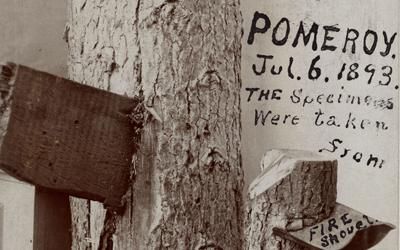
Description
This cabinet card photograph shows relics of the 1893 Cherokee-Pomeroy tornado collected from "Slater's Farm," which was located 3 miles south of Aurelia, Iowa.
Portrait of 6-Month-Old Baby Carried by Cherokee-Pomeroy Tornado, 1893
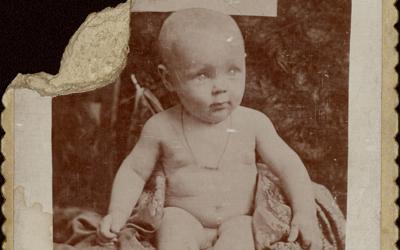
Description
This cabinet card photograph shows a 6-month-old child who was allegedly carried three-quarters of a mile by the Cherokee-Pomeroy tornado of July 6, 1893.
Iowa Public Television's "The Dust Bowl," 1979

Description
This 1979 video was produced by Iowa Public Television. It focused on the impact of the Dust Bowl on Iowa farms and farmers.
Iowa Public Television's "Midwest Farm Fields Devastated by Floods," 2008

Description
This Iowa Public Television video was produced in 2008 and focused on how Midwestern farm fields were destroyed by severe 2008 flooding. The video also covered how farmers were dealing with the crisis.
Men Placing Sandbags to Reinforce Dikes during a Flood in Council Bluffs, Iowa, 1952
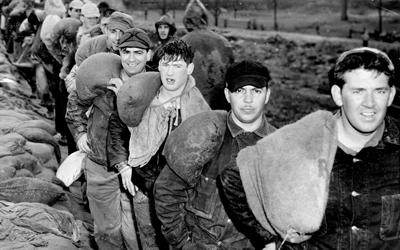
Description
This photograph shows workers filling and placing sandbags to reinforce dikes during Missouri River flooding in Council Bluffs, Iowa. The severe flooding occurred in April 1952.
Iowa Public Television's "Iowa After the 2008 Parkersburg Tornado," 2008
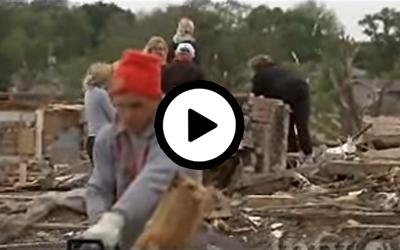
Description
This video was produced by Iowa Public Television, and it details the devastation of the F-5 tornado that ripped through Parkersburg, Iowa, in 2008. The video details the damage, as well as the recovery effort, of those affected by the tornado.
"Cedar Rapids Flood Buyout is History" Newspaper Article, September 14, 2014
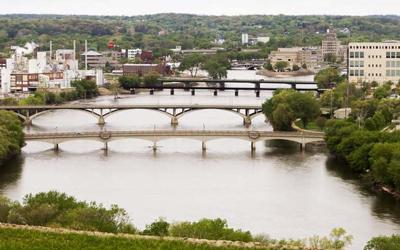
Description
This newspaper article from the The Cedar Rapids Gazette in September 2014 details the historic flood buyout that took place after the devastating 2008 flooding. Funds totaling millions of dollars were spent to purchase residential and commercial land owned in the…
NPR's "MAP: FEMA Is Buying Out Flood-Prone Homes, But Not Where You Might Expect," October 20, 2014
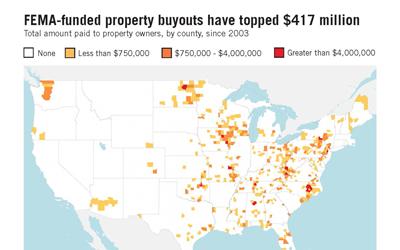
Description
From National Public Radio’s analysis of Federal Emergency Management Agency (FEMA) data, this map shows the total amount paid to property owners (by county), since 2003, and a chart of the 10 biggest disaster buyout totals.
Additional Resources
- "City in Iowa Rebuilds From Flooding but Remains Vulnerable" Newspaper Article
This New York Times newspaper article by John Eligon focuses on the recovery of eastern Iowa five years after horrific and destructive flooding. - Peoples' Weather Map
The Peoples' Weather Map (PWM) is a web-based map of severe weather stories in Iowa (U.S.). On the map, users can explore historical and recent severe weather events, through words and images, in individual counties. PWM's emphasis is, in fact, stories rather than data, but the map also provides users links to weather hazard and climate data to explore. Through videotaped interviews, PWM introduces some of Iowa’s climate scientists. - "Snowstorms and Iowa’s High School State Basketball Tournaments" Facts
This factsheet created by the National Weather Service focuses on the snowfall and extreme weather that typically happens the last two weeks of March, which is typically when the Iowa high school basketball state tournament occurs. - "The Top Five Iowa Floods"
This National Weather Service report looks at the first worst floods to ever occur in Iowa. They were selected as follows: 1) 1993 (Statewide), 2) 2008 (Eastern Iowa), 3) 1851 (Des Moines River Basin), 4) July 4, 1876 (Rockdale), T5) 1965 (Mississippi River), T5) 1952 (Missouri River).
Iowa Core Social Studies Standards (6th-12th Grade)
Listed below are the Iowa Core Social Studies content anchor standards that are best reflected in this source set. The content standards applied to this set are high school-age level and encompass the key disciplines that make up social studies for 6th through 12th grade students.
| No. | Standard Description |
| SS.6.17. | Analyze and explain the cultural, physical, and environmental characteristics of places and regions and how this affects the life of the people who live there. |
| SS-Geo.9-12.16. | Analyze relationships and interactions within and between human and physical systems to explain reciprocal influences |
| SS-Geo.9-12.23. | Analyze the consequences of human-made and natural catastrophes on global trade, politics, and human migration |